
Issue 152 | February 26, 2013 | Archive
News & Events
Water and Weeds
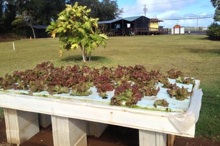 Heads-up
for some upcoming useful information: Local Immigrant Farmer Education (LIFE)
and Risk Management Hawaii (RMH) will be hosting two workshops on Hydroponics for
Ag Tourism and School Systems at Kahuku Farms, located at 56-800 Kamehameha
Hwy. Part I will be held on Feb. 26 from 10 a.m. to noon, while Part II takes
place on March 3 from 9 to 11 a.m. Participants will learn such important
information as what crops and varieties do best in hydroponic systems, what
government programs are associated with hydroponic ag tourism, and how best to
incorporate food safety in the systems. Then it’s off to the Big Island for a
2-day workshop and field demonstration on weed management, where Joe DeFrank (TPSS) will
demonstrate both chemical and non-chemical methods of killing weeds such as
yellow nutsedge. The workshop will be given at the Waimea Civic Center (67-5189
Kamamalu Road) on March 7 from 6 to 8 p.m., while the field demo will be offered
9–9:45 a.m. at Nakamoto Farm in Kamuela. Participants who wish to receive
credits towards pesticide recertification should bring their pesticide cards,
and there will also be information useful to organic growers. For the
hydroponics events, call Lynn at 622-4185 to register; for the weed control,
call Didi or Perci at 887-6183 or email mddiaz@hawaii.edu.
Heads-up
for some upcoming useful information: Local Immigrant Farmer Education (LIFE)
and Risk Management Hawaii (RMH) will be hosting two workshops on Hydroponics for
Ag Tourism and School Systems at Kahuku Farms, located at 56-800 Kamehameha
Hwy. Part I will be held on Feb. 26 from 10 a.m. to noon, while Part II takes
place on March 3 from 9 to 11 a.m. Participants will learn such important
information as what crops and varieties do best in hydroponic systems, what
government programs are associated with hydroponic ag tourism, and how best to
incorporate food safety in the systems. Then it’s off to the Big Island for a
2-day workshop and field demonstration on weed management, where Joe DeFrank (TPSS) will
demonstrate both chemical and non-chemical methods of killing weeds such as
yellow nutsedge. The workshop will be given at the Waimea Civic Center (67-5189
Kamamalu Road) on March 7 from 6 to 8 p.m., while the field demo will be offered
9–9:45 a.m. at Nakamoto Farm in Kamuela. Participants who wish to receive
credits towards pesticide recertification should bring their pesticide cards,
and there will also be information useful to organic growers. For the
hydroponics events, call Lynn at 622-4185 to register; for the weed control,
call Didi or Perci at 887-6183 or email mddiaz@hawaii.edu.
When Is a Crop Not Just a Crop?
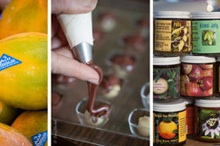 The Pearl
City Urban Garden Center will be hosting one of a series of workshops presented
by educators and longtime CTAHR collaborators Craig Elevitch and Ken Love on
making family-farm crops more marketable and profitable. The workshop, which
will be held March 28 from 9:00 a.m. to noon, will discuss ways to add value to
agricultural products, covering an array of topics including creating a brand
identity, developing market niches, using certifications to increase product
worth, and pricing for a range of markets. Click here to see the
other dates and locations the workshop will be held and to pre-register for
free.
The Pearl
City Urban Garden Center will be hosting one of a series of workshops presented
by educators and longtime CTAHR collaborators Craig Elevitch and Ken Love on
making family-farm crops more marketable and profitable. The workshop, which
will be held March 28 from 9:00 a.m. to noon, will discuss ways to add value to
agricultural products, covering an array of topics including creating a brand
identity, developing market niches, using certifications to increase product
worth, and pricing for a range of markets. Click here to see the
other dates and locations the workshop will be held and to pre-register for
free.
Getting Back to the Roots
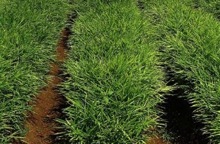 Save the
date for the
annual ginger growers’ meeting, which this year will include presentations by Linda
Cox (NREM), Susan Miyasaka and Ferol White (TPSS), and Sharon Motomura (Hawai‘i
County extension). The meeting, which will be held on Mar. 13, 6:30–8:30 p.m.
at UH-Hilo Campus Center Room 306, will be the last one for ginger growers
participating in the research study to receive FREE bacterial wilt-free ginger
seed pieces for planting. There’s no cost to attend, and parking for the event
is free. Commercial
growers who are interested in participating should contact Sharon Motomura at smotomur@hawaii.edu or at 808-969-8250,
while backyard growers or researchers should contact Ferol White at ferol@hawaii.edu
or 808-969-8267.
Save the
date for the
annual ginger growers’ meeting, which this year will include presentations by Linda
Cox (NREM), Susan Miyasaka and Ferol White (TPSS), and Sharon Motomura (Hawai‘i
County extension). The meeting, which will be held on Mar. 13, 6:30–8:30 p.m.
at UH-Hilo Campus Center Room 306, will be the last one for ginger growers
participating in the research study to receive FREE bacterial wilt-free ginger
seed pieces for planting. There’s no cost to attend, and parking for the event
is free. Commercial
growers who are interested in participating should contact Sharon Motomura at smotomur@hawaii.edu or at 808-969-8250,
while backyard growers or researchers should contact Ferol White at ferol@hawaii.edu
or 808-969-8267.
Grants & Awards
Fab Foodies
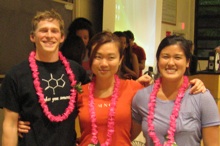 Do you
know how many hectares in Africa are used for growing acai palms? Or where the
US ranks in terms of global food security? Or even the optimal temperature and
amount of time to store cooked rice? Well, the winning team of the second
annual CTAHR Food Systems Quiz Bowl does, plus a whole lot more. HNFAS’s team
the French Toast Mafia, consisting of Yvonne Lee, Tracy Sy, and David St.
Jules, swept the competition in the Jeopardy!-style game on Friday, but everyone
was a winner at the delicious dinner afterward. Thanks to the students in
ANSC/FSHN 601 The Science of Food Systems for writing up the tricky and
informative questions!
Do you
know how many hectares in Africa are used for growing acai palms? Or where the
US ranks in terms of global food security? Or even the optimal temperature and
amount of time to store cooked rice? Well, the winning team of the second
annual CTAHR Food Systems Quiz Bowl does, plus a whole lot more. HNFAS’s team
the French Toast Mafia, consisting of Yvonne Lee, Tracy Sy, and David St.
Jules, swept the competition in the Jeopardy!-style game on Friday, but everyone
was a winner at the delicious dinner afterward. Thanks to the students in
ANSC/FSHN 601 The Science of Food Systems for writing up the tricky and
informative questions!
Fungal Biofuel
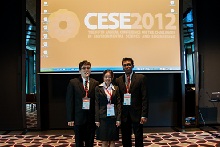 Recent MBBE Ph.D. graduate Saoharit “Pikky” Nitayavardhana was awarded the Best Student Oral Presentation Award at the International Conference on “Challenges in Environmental Science and Engineering (CESE-2012)” held in Melbourne, Australia, on September 9 to 13. Her presentation was on “Biofuel residues conversion into aquatic feed via fungal fermentation,” arising from her Ph.D. research under the supervision of Samir Khanal. Pikky (pictured, middle, between Samir Khanal’s students Devin Takara and Dradeep Munasinghe) is originally from Thailand and earned her M.S. from Asian Institute of Technology, Thailand, with a perfect GPA of 4.0.
Recent MBBE Ph.D. graduate Saoharit “Pikky” Nitayavardhana was awarded the Best Student Oral Presentation Award at the International Conference on “Challenges in Environmental Science and Engineering (CESE-2012)” held in Melbourne, Australia, on September 9 to 13. Her presentation was on “Biofuel residues conversion into aquatic feed via fungal fermentation,” arising from her Ph.D. research under the supervision of Samir Khanal. Pikky (pictured, middle, between Samir Khanal’s students Devin Takara and Dradeep Munasinghe) is originally from Thailand and earned her M.S. from Asian Institute of Technology, Thailand, with a perfect GPA of 4.0.
Spotlight on Our Community
Fighting Fireweed With Fireweed Moth
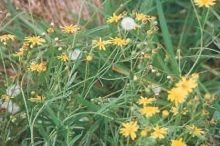 The
biocontrol agent the Madagascan Fireweed Moth has
just been released on Hawai‘i Island, and hopes are high it will be a
major ally in the fight against the invasive Madagascar fireweed, which is
toxic to cattle and horses and which also takes up nutrients and water needed by
other native and beneficial plant species. CTAHR researchers including Tomoaki
Miura and James Leary (both NREM) and Mark Thorne (HNFAS), as well as the staff of the Mealani Research Station, helped to map the
range and spread of the weed for assessment and monitoring purposes and to
raise and release the moth’s larvae; monitoring will be continued of the moth’s
spread and the fireweed’s hopeful decline.
The
biocontrol agent the Madagascan Fireweed Moth has
just been released on Hawai‘i Island, and hopes are high it will be a
major ally in the fight against the invasive Madagascar fireweed, which is
toxic to cattle and horses and which also takes up nutrients and water needed by
other native and beneficial plant species. CTAHR researchers including Tomoaki
Miura and James Leary (both NREM) and Mark Thorne (HNFAS), as well as the staff of the Mealani Research Station, helped to map the
range and spread of the weed for assessment and monitoring purposes and to
raise and release the moth’s larvae; monitoring will be continued of the moth’s
spread and the fireweed’s hopeful decline.
Moth Mystery
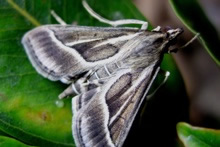 Dan
Rubinoff and William Haines (both PEPS) were recently interviewed on HPR about their paper published last month in the
scientific journal PLOS ONE on the native moth Omiodes continuatalis. The moth, which first
appeared on the islands of Kaua‘i and O‘ahu 3 million years ago, has
disappeared from much of its original range and is now only found in small
portions of its habitat on Maui and the Big Island. It has even disappeared
from Koke‘e on Kaua‘i, which is considered to be a substantially intact native
area. Dan and William explain that the moth’s decline is probably due to
invasive species of ants and wasps, but that they’re unsure of the exact cause.
But since, as they point out, insects are the basis of ecosystems, it’s necessary
to find out what’s killing off insect species—and stop it, if possible. More
quarantine and inspection control are a good start, they advise—of construction
materials as well as agricultural and food items.
Dan
Rubinoff and William Haines (both PEPS) were recently interviewed on HPR about their paper published last month in the
scientific journal PLOS ONE on the native moth Omiodes continuatalis. The moth, which first
appeared on the islands of Kaua‘i and O‘ahu 3 million years ago, has
disappeared from much of its original range and is now only found in small
portions of its habitat on Maui and the Big Island. It has even disappeared
from Koke‘e on Kaua‘i, which is considered to be a substantially intact native
area. Dan and William explain that the moth’s decline is probably due to
invasive species of ants and wasps, but that they’re unsure of the exact cause.
But since, as they point out, insects are the basis of ecosystems, it’s necessary
to find out what’s killing off insect species—and stop it, if possible. More
quarantine and inspection control are a good start, they advise—of construction
materials as well as agricultural and food items.
A Fashion Maven Is Born
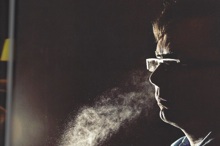 Andy
Reilly (APDM) was recently profiled in Flux magazine on early influences that
led to his interest in clothing and fashion, such as a sky-blue-and-gold-striped suit he had when he was 5 years old and his early experiments in
designing clothes sewn out of paper towels. He also discusses the accessory
that most defines his personal style as an adult—fragrances, he says,
especially those that echo his more mature fashion sense—“different but
subtle.”
Andy
Reilly (APDM) was recently profiled in Flux magazine on early influences that
led to his interest in clothing and fashion, such as a sky-blue-and-gold-striped suit he had when he was 5 years old and his early experiments in
designing clothes sewn out of paper towels. He also discusses the accessory
that most defines his personal style as an adult—fragrances, he says,
especially those that echo his more mature fashion sense—“different but
subtle.”
Step Right Up to Spring
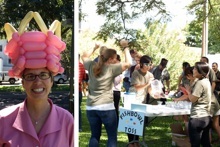 About 200 CTAHR students,
faculty, and staff came out for food and fun at CTAHR’s annual Spring Event,
where this year, instead of the traditional dodgeball competition, participants
enjoyed an outdoor carnival. Entertainment included homemade games like
sidewalk bowling and trying to catch a bounced ball in a hat…while wearing it.
Professional balloon artists from Adventure Balloons wowed the crowd with their
skill and creativity, twisting such masterpieces as Dean Gallo’s crown and
dunking booth volunteer Halina Zaleski’s (HNFAS) pig with wings. The highlight
was certainly the dunking booth, where all enjoyed watching brave faculty
plunge into the water: the dripping crew also included Ken Leonhardt (TPSS), CN
Lee and Maria Stewart (both HNFAS), and Mark Wright and Dan Rubinoff (both
PEPS). Monetary donations of $520 were collected to support Collegiate 4-H, a
CTAHR-affiliated program that fosters leadership and personal development in
today’s youth through hands-on learning projects in the community. Mahalo to
Charlie Nelson and Ryan Kurasaki for helping with food arrangements, and to
Janice Uchida for donating potted plants for prizes. Thanks to the Spring Event
student committee, scholarship recipients, and ASAO for their time and
dedication in making this a smooth and successful event, and thank you to
everyone who attended and donated to this year’s cause for making this
first-time carnival-themed Spring Event a memorable one.
About 200 CTAHR students,
faculty, and staff came out for food and fun at CTAHR’s annual Spring Event,
where this year, instead of the traditional dodgeball competition, participants
enjoyed an outdoor carnival. Entertainment included homemade games like
sidewalk bowling and trying to catch a bounced ball in a hat…while wearing it.
Professional balloon artists from Adventure Balloons wowed the crowd with their
skill and creativity, twisting such masterpieces as Dean Gallo’s crown and
dunking booth volunteer Halina Zaleski’s (HNFAS) pig with wings. The highlight
was certainly the dunking booth, where all enjoyed watching brave faculty
plunge into the water: the dripping crew also included Ken Leonhardt (TPSS), CN
Lee and Maria Stewart (both HNFAS), and Mark Wright and Dan Rubinoff (both
PEPS). Monetary donations of $520 were collected to support Collegiate 4-H, a
CTAHR-affiliated program that fosters leadership and personal development in
today’s youth through hands-on learning projects in the community. Mahalo to
Charlie Nelson and Ryan Kurasaki for helping with food arrangements, and to
Janice Uchida for donating potted plants for prizes. Thanks to the Spring Event
student committee, scholarship recipients, and ASAO for their time and
dedication in making this a smooth and successful event, and thank you to
everyone who attended and donated to this year’s cause for making this
first-time carnival-themed Spring Event a memorable one.
You Go, GoFarm!
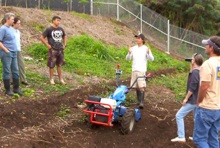 UH News recently released a video report on the GoFarm Hawai‘i program, describing how the program, which is part of the
Community College Career Training program (C3T Hawai‘i), mentors students in a
process of ever-increasing immersion in the life of farming. CTAHR faculty and
staff are partnering with farmers for the 18-month-long program that will, it
is hoped, add many more farmers and agricultural workers to the Island
landscape. GoFarm! was also featured on KITV News, in a segment explaining how the 13 students in this class are learning everything from how to prep their seeds and till the soil to how to run an agricultural business. After graduating, each student will be allowed to use a half-acre of land at the Waimanalo Research Station on which to grow their crops and further their training.
UH News recently released a video report on the GoFarm Hawai‘i program, describing how the program, which is part of the
Community College Career Training program (C3T Hawai‘i), mentors students in a
process of ever-increasing immersion in the life of farming. CTAHR faculty and
staff are partnering with farmers for the 18-month-long program that will, it
is hoped, add many more farmers and agricultural workers to the Island
landscape. GoFarm! was also featured on KITV News, in a segment explaining how the 13 students in this class are learning everything from how to prep their seeds and till the soil to how to run an agricultural business. After graduating, each student will be allowed to use a half-acre of land at the Waimanalo Research Station on which to grow their crops and further their training.
Down With Diamondbacks
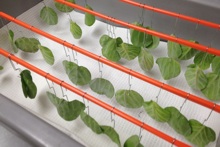 The
diamondback moth (DBM) (Plutella xylostella (L.)) is a pest of crucifers such
as cabbage and broccoli that can severely damage crops and render them
unmarketable. The moth is difficult to control because it readily grows
resistant to insecticides, and CTAHR Extension professionals have worked with
commercial crucifer crop growers on an insecticide-resistance management
program since DBM’s insecticide resistance in Hawai‘i was discovered in 2000.
Thirteen years later, DBM Insecticide Resistance Management (IRM) team members
Robin Shimabuku, Randy Hamasaki, and Jari Sugano (all
PEPS) , Ronald Mau (PEPS emeritus); Jensen Uyeda (TPSS); Steve Fukuda (TPSS emeritus); Ming Yi Chou, and Sharon
Motomura (Hawai‘i County Extension) are continuing field and laboratory
bioassays to evaluate new chemical classes for the IRM rotation program and
monitor resistance levels to chemicals in the current statewide DBM IRM program
at least twice a year. Managing and tracking insecticide resistance in
commercial areas is an important component in sustaining Hawai‘i’s crucifer
crop industries, which are themselves important to the Islands’ food security.
The
diamondback moth (DBM) (Plutella xylostella (L.)) is a pest of crucifers such
as cabbage and broccoli that can severely damage crops and render them
unmarketable. The moth is difficult to control because it readily grows
resistant to insecticides, and CTAHR Extension professionals have worked with
commercial crucifer crop growers on an insecticide-resistance management
program since DBM’s insecticide resistance in Hawai‘i was discovered in 2000.
Thirteen years later, DBM Insecticide Resistance Management (IRM) team members
Robin Shimabuku, Randy Hamasaki, and Jari Sugano (all
PEPS) , Ronald Mau (PEPS emeritus); Jensen Uyeda (TPSS); Steve Fukuda (TPSS emeritus); Ming Yi Chou, and Sharon
Motomura (Hawai‘i County Extension) are continuing field and laboratory
bioassays to evaluate new chemical classes for the IRM rotation program and
monitor resistance levels to chemicals in the current statewide DBM IRM program
at least twice a year. Managing and tracking insecticide resistance in
commercial areas is an important component in sustaining Hawai‘i’s crucifer
crop industries, which are themselves important to the Islands’ food security.
State of the State, State of CTAHR
 Good
news—Governor Neil Abercrombie gave a shout-out to Dean Gallo and CTAHR’s
“integral” role in “nurturing Hawai‘i’s agriculture industry” in his
2013 State of the
State address. He praised the “vigorous leadership”
of Dr. Gallo, saying the college “is poised to meet critical research and
extension needs if given the support.” Support—what a great idea!
Good
news—Governor Neil Abercrombie gave a shout-out to Dean Gallo and CTAHR’s
“integral” role in “nurturing Hawai‘i’s agriculture industry” in his
2013 State of the
State address. He praised the “vigorous leadership”
of Dr. Gallo, saying the college “is poised to meet critical research and
extension needs if given the support.” Support—what a great idea!
Credit From the Credit Unions
 Michael Cheang’s Kids Savings project partners schools with
credit unions and investors to provide children with seed money and support to
start their own savings accounts, which Michael hopes will help combat the widespread
financial illiteracy in our society. A recent event to honor participating
elementary school teachers who created games to foster financial savvy among
their third-graders was reported glowingly in the Hawaii Credit Union League’s
newsletter. The story explained that these teachers were building on Michael’s
project to instruct their students on the common core standards as well as
dollars and cents.
Michael Cheang’s Kids Savings project partners schools with
credit unions and investors to provide children with seed money and support to
start their own savings accounts, which Michael hopes will help combat the widespread
financial illiteracy in our society. A recent event to honor participating
elementary school teachers who created games to foster financial savvy among
their third-graders was reported glowingly in the Hawaii Credit Union League’s
newsletter. The story explained that these teachers were building on Michael’s
project to instruct their students on the common core standards as well as
dollars and cents.
Going With the Grain
 If you're interested in furniture, art, and sustainability, you'll want to check out the UH System video featuring JB Friday’s young koa tree project. Last year JB Friday (NREM) supplied some koa to the UHM art department in order to see how woodworkers might use wood from young, second-growth koa, as opposed to the old-growth koa commonly used in the current industry. An art class made 11 benches showcasing the wood’s distinctive and beautiful grain, and these were displayed at the UHM gallery and then at the fishcake art/furniture gallery in Kaka‘ako. JB emphasizes that koa from managed or planted forests can be an important addition to the economic and ecological landscape of the Islands: Landowners will have more of an incentive to replant with the native koa, providing watershed protection and habitat for other native species, if they are assured of a market for their wood.
If you're interested in furniture, art, and sustainability, you'll want to check out the UH System video featuring JB Friday’s young koa tree project. Last year JB Friday (NREM) supplied some koa to the UHM art department in order to see how woodworkers might use wood from young, second-growth koa, as opposed to the old-growth koa commonly used in the current industry. An art class made 11 benches showcasing the wood’s distinctive and beautiful grain, and these were displayed at the UHM gallery and then at the fishcake art/furniture gallery in Kaka‘ako. JB emphasizes that koa from managed or planted forests can be an important addition to the economic and ecological landscape of the Islands: Landowners will have more of an incentive to replant with the native koa, providing watershed protection and habitat for other native species, if they are assured of a market for their wood.
Bioenergy From Down Under
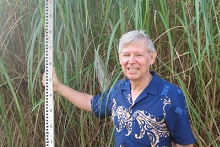 Doug George will be working with Andy Hashimoto (MBBE) on the $6 million grant he recently received to study sustainable biofuel systems to increase the Islands’ energy security. Dr. George will be collaborating on the project until April 2013, while on sabbatical from the University of Queensland. An agronomist with a background in plant breeding (mainly sunflowers), he has already begun research on bioenergy crops, including sugarcane, bana grass, native grasses, and eucalyptus trees on the UQ Gatton Campus.
Doug George will be working with Andy Hashimoto (MBBE) on the $6 million grant he recently received to study sustainable biofuel systems to increase the Islands’ energy security. Dr. George will be collaborating on the project until April 2013, while on sabbatical from the University of Queensland. An agronomist with a background in plant breeding (mainly sunflowers), he has already begun research on bioenergy crops, including sugarcane, bana grass, native grasses, and eucalyptus trees on the UQ Gatton Campus.
New Publications
Ginger Woes
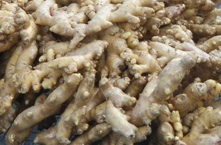 Troubled
by yellowed, necrotic ginger? You’ll need to check out the new website about bacterial wilt of edible ginger, a serious pest that has
substantially reduced the economic value of ginger in the state. The project to
research management options and educate the public on how to deal with the
disease is led by Susan Miyasaka (TPSS); other collaborators include Linda Cox
(NREM), Scot Nelson (PEPS), Bernard Kratky (TPSS emeritus), and community
stakeholders. If your ginger is wilting, don’t delay—check it out today!
Troubled
by yellowed, necrotic ginger? You’ll need to check out the new website about bacterial wilt of edible ginger, a serious pest that has
substantially reduced the economic value of ginger in the state. The project to
research management options and educate the public on how to deal with the
disease is led by Susan Miyasaka (TPSS); other collaborators include Linda Cox
(NREM), Scot Nelson (PEPS), Bernard Kratky (TPSS emeritus), and community
stakeholders. If your ginger is wilting, don’t delay—check it out today!
Help From Palau
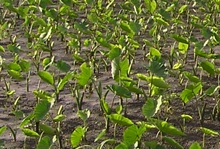 Susan
Miyasaka recently
published an article
in HortTechnology
on taro leaf blight (TLB), based on her 12 years of evaluation of taro
germplasm along the Hamakua Coast of the Big Island. Of the 5 cultivars that
showed the greatest resistances to TLB and corm rots, 'Dirratengadik', 'Merii', 'Ngesuas', 'Ochelochel', and 'Sawa Bastora', 4 originated from Palau. In contrast,
2 commercial cultivars from Hawai‘i, 'Bun Long' and 'Maui Lehua', were quite
susceptible to TLB and corm rot. This indicates, Dr. Miyasaka explains, that
conventional breeding of taro to improve TLB resistance could improve yields of
commercial taro cultivars.
Susan
Miyasaka recently
published an article
in HortTechnology
on taro leaf blight (TLB), based on her 12 years of evaluation of taro
germplasm along the Hamakua Coast of the Big Island. Of the 5 cultivars that
showed the greatest resistances to TLB and corm rots, 'Dirratengadik', 'Merii', 'Ngesuas', 'Ochelochel', and 'Sawa Bastora', 4 originated from Palau. In contrast,
2 commercial cultivars from Hawai‘i, 'Bun Long' and 'Maui Lehua', were quite
susceptible to TLB and corm rot. This indicates, Dr. Miyasaka explains, that
conventional breeding of taro to improve TLB resistance could improve yields of
commercial taro cultivars.
The “Doctor” Is in…Cyberspace
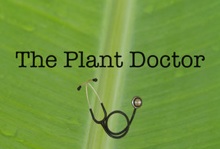 For those who have one hand dug deep in the soil and the other on the pulse of technology, the Android version of “The Plant Doctor” app is now
available, ready to function on more than 2,100 different Android devices! The
app download and interactive diagnoses of plant health problems are free, as
are the suggestions for pest management. The IOS version for iPhone and iPad is
available at the iTunes store. During the past month the intrepid and indefatigable plant doctors have diagnosed problems from India, China, Iran, England, Canada, and
several states in USA, including Hawai‘i.
For those who have one hand dug deep in the soil and the other on the pulse of technology, the Android version of “The Plant Doctor” app is now
available, ready to function on more than 2,100 different Android devices! The
app download and interactive diagnoses of plant health problems are free, as
are the suggestions for pest management. The IOS version for iPhone and iPad is
available at the iTunes store. During the past month the intrepid and indefatigable plant doctors have diagnosed problems from India, China, Iran, England, Canada, and
several states in USA, including Hawai‘i.
Help our community to keep in touch! Please send news items -- awards, grants, special projects, special people -- and pictures to Frederika Bain at ctahrnotes@ctahr.hawaii.edu. Also refer to the submission information and guidelines.
CTAHR faculty and staff can always check for the latest new funding opportunities.
Do you have an upcoming event that you'd like to promote? CTAHR faculty and staff can post events to the CTAHR website's calendar.
All CTAHR Notes readers can browse the calendar to learn more about the college's activities.